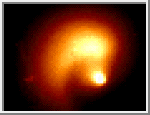 Contents |
What's New |
Image Index |
Copyright |
Puzzles |
Story Hobby/ |
Posters |
Search |
Contents |
What's New |
Image Index |
Copyright |
Puzzles |
Story Hobby/ |
Posters |
Search |
| ||||||||||||||||||

Courtesy of the Jet Propulsion Laboratory
Make a Comet NucleusComets are made up of some of the original material from which the solar system formed. Orbiting far from the Sun, this primordial material has survived in an unaltered state for billions of years. When a comet nucleus is gravitationally drawn into the inner solar system it begins to heat up. The volatile materials from which it is made boil off to form the head and tail(s) that have amazed, baffled, and frightened people throughout history. This tremendous light show is produced from just the small solid nucleus measuring only 15 or 20 kilometers long. Think of it as a very dirty iceberg! This view was confirmed by the spacecraft flybys of Halley's Comet by Japanese, Soviet and European spacecraft in 1986. You can make an accurate model of a comet nucleus easily and inexpensively. Unfortunately it is difficult to do it neatly. Here is what you need:
These ingredients are either actual components or handy analogous ones. The dry ice is frozen carbon dioxide. Water, ammonia, organic (carbon based) molecules, and silicates are all present on comet nuclei. They have been identified through spectral measurements of comet tails and the collection of tiny ice particles by very high flying research aircraft. Here is the recipe:Line the bowl with a trash bag. Place the other trash bag on the floor. Pour about a pint of water into the bowl. Add the corn starch or Worcester sauce, ammonia, and some of the dirt; mix a bit. Put on the gloves. Wrap the dry ice in a cloth towel; place it over the trash bag on the floor. Use the hammer to grind up the dry ice into a powder. Gradually pour the dry ice powder into the water, mixing as you pour. There will be lots of vapor formed. The dry ice, water and other ingredients should form a thickening slush. Keep stirring for a few seconds as it thickens. Now, using the trash bag to lift the slush away from the sides of the bowl, use your gloved hands to pack the slush into a ball. Keep packing and forming until the ball solidifies as a big lump. Peel back the trash bag. Scatter some more dirt over the lump. Pour some of the remaining water over the lump, turning it as you do so, so that a layer of water ice forms over the entire lump. Observe the behavior of your miniature comet nucleus. It can be handled without gloves if the water ice coating is intact. If a spot feels sticky, pour water on the spot. It hisses and pops as carbon dioxide sublimes (goes from the solid state directly into a gas) and forces its way through weak spots in the water ice crust. On real nuclei this results in slight jetting forces that can cause the nucleus to spin, slightly alter its orbit, or split apart (or "calve"). Note: Get three or four pounds of dry ice for each nucleus you plan to make. You can purchase it the afternoon or evening prior to the demonstration and store it in a freezer or ice chest. Place an inch or so of newspaper below the dry ice to prevent cracking of the surface on which the dry ice rests. Try the demonstration first to get an idea of the correct amount of water to use. It's fun, it's a mess, and it's one of the most memorable and scientifically accurate demonstrations in astronomy! |
